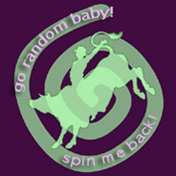A Tetherd Cow Ahead Public Service Post.
A little ways back I threatened to write something with the above title, and Cowpokes, that day has arrived! Using this handy guide whilst simultaneously stroking your lucky ShooWooWoo™ talisman will absolutely guarantee that you will never again run afoul of swindlers and mountebanks.
I don’t need to tell you that the aforementioned snake oil vendors have about a million tricks up their sleeves when it comes to separating a sucker from his cash, but fortunately, most of their chicanery settles into fairly well worn patterns. So. Let us begin:
1. There’s No Such Thing as a Free Lunch
Most forms of flim-flam promise a quick and/or disproportionately large profit on the back of a small outlay. ((The down-payment may not necessarily be monetarily small – a good example of this is ‘alternative’ medicine, where the treatments can in fact be outrageously expensive, especially given the actual expense being outlaid by the practitioner. In this case, the proportionate size of the return is based on the low impact of the treatment in the initial instance. For example: the moderate process of undergoing homeopathic treatment in contrast to, say, chemotherapy or surgery.)) The mantra here must surely be: If it seems too good to be true, it probably is.
This seems to me to be so self-evident that it hardly bears mentioning, but plainly, a great number of people never develop the appropriate neural pathways to comprehend it sufficiently, even, it seems, after they’ve been burnt many times. If you obey this one rule alone, you’ll avoid falling into the clutches of most con artists.
Tetherd Cow Avoidance Advice: When you hear of something that seems like a remarkably good exchange, ask yourself what the other person stands to gain. If it’s your money or your soul, walk away.
2. It’s Not Rocket Science
Beware of claims that invoke ‘fuzzy’ areas of science, like quantum mechanics, magnetism, plasma, ‘energy fields’ and so forth. Particularly if used in conjunction with ‘feel good’ concepts like ‘environmentally friendly’ or ‘non toxic’.
The technique at work here is one of ‘blinding the sucker with science’. It typically takes the form of the scammer picking some kind of scientific concept that is tricky for the layperson to understand, and attempting to make it sound plausible in relationship to their product. We see mild versions of this in advertising, where white-coated ‘scientists’ talk about the scientific principles at work behind washing powders ((Detergent chemistry is seriously dull, and any advertiser knows that ‘dull’ is never going to move units. So the brainless ‘oxy-whiz’ and ‘ultra-brightoids’ that get invoked in these ads are just made-up nonsense.)), but it really comes into its own in scams. Peddlers of nonsense as diverse as ‘electromagnetic’ pest control and ‘vibrational’ water just love to try and make you think that there’s science behind their wares – quite baffling, really, when the very same peddlers typically vilify scientists for ‘pretending to know everything’.
Tetherd Cow Avoidance Advice: Beware words and phrases that sound like they come from Star Trek.
3. Gurus are Bad News
People who proclaim that they can help you change your life for the better for a fee, ((And be cautious here – the fee doesn’t have to be money.)) almost always mean ‘better for them’.
There is a kind of person (among the most despicable of the despicable) who seems supremely adept at finding unhappy, lonely or damaged people and happily taking away their money (or their dignity – or anything else they can get their grubby mits on). Unfortunately, these kinds of crooks are almost always uncannily charismatic, and more often than not, intelligently cunning. They often have an innate understanding of brainwashing techniques, and many have even studied such methods for manipulating their victims. They appear to have no conscience, and if exposed, often take up their racket again at the first available opportunity.
Such people frequently claim to be in possession of ‘special knowledge’ imparted to them under supernatural circumstances. There is, of course, no effective refutation ((You can’t easily demand proof of an experience of this kind – the Guru will characteristically claim that the knowledge is the proof.)) of these kinds of claims, and that is leverage of considerable power for fragile or disenchanted people. Examples include:
•L Ron Hubbard
•Peter Popoff
•Rael
•The Pope
Tetherd Cow Avoidance Advice:Ask yourself what the most notable achievement of the guru is. If the answer is ‘Being a guru’, walk away.
4. Ancient Wisdom is Most Likely Past its Expiry Date
Just because something has history behind it, doesn’t mean it has logic or evidence behind it. This is a problem we find particularly, but not exclusively, with medicine. ((Most religions have this card in play. I submit that the only reason that Scientology is not more successful than, say, Catholicism is because it doesn’t have a couple of centuries of mythology behind it. Rationally speaking, there’s not a lot of difference between what Scientologists believe and what Catholics believe.)) There is a strong belief among many people that ‘we were better off in the olden days’ because we ‘weren’t so technological’, the logical extension of that being that technology is a bad thing.
Now, while there’s a lot to be said for being careful about what we do with technology and the planet, there is no evidence that we were ‘better off’ in any quantifiable way before we had it. ((The concept of ‘technology’ being evil is, in itself, an absurdity as I’m sure you are aware – humans have had technology since one of our enterprising ancestors sharpened a stick to toast marshmallows)) Take vaccination, for instance. A dangerous idea that is currently doing the rounds is that vaccination is somehow a bad thing ((The rationale being that vaccination is some kind of Evil Plot concocted by the pharmaceutical companies to fleece us of our money)). The evidence is in fact quite to the contrary if you know even a little history and a little science. And yet, thousands of people are currently climbing on the anti-vaccination bandwagon to their own detriment, and ultimately to the detriment of us all. Equally worrying are 18th century notions like homeopathy, or folk wisdom such as that which dominates ‘traditional’ Chinese medicine.
In general, the bucolic and happy world of our forefathers is a shiny myth, and most people couldn’t even survive a month without running water, food delivered to their door, modern medicine and technological forms of shelter and transport.
Tetherd Cow Avoidance Advice: If you are tempted to think that the ancients knew all the answers, remember the last time you went camping. Now, imagine doing that for a year, but without the tent, the bug repellent and the single malt whisky ((Oh, OK – they had the whisky. That’s why it was invented.)).
5. Mother Nature Doesn’t Necessarily Know Best
(This is related to #4, but has some shades of difference)
Just because something is ‘natural’ doesn’t mean it is:
A): Better than something artificial, or:
B): Harmless.
There has been over the last few decades a vogue for ‘natural’ therapies of various kinds, the understanding being that something that comes from ‘nature’ must be superior to, and less harmful than, something created by humans. ((It’s logically stupid anyway, considering that humans are ‘natural’ so it follows that anything they do is also ‘natural’, even if it is to create something that doesn’t occur naturally.)) This is plainly absurd for so many reasons. Sickness and disease (and indeed, death), are quite natural, so doing anything to thwart their process is actually interfering with a ‘natural’ process – whether you choose to chew a herb or have genetic therapy. How you determine the acceptability of ‘naturalness’ of the treatment must, therefore, necessarily be a subjective judgement. Aside from anything, you can quite easily damage or kill yourself with things found in the natural world – nature is as good at concocting lethal chemicals as humans. Better, even.
Tetherd Cow Avoidance Advice: Ponder on the established fact that, for the most part, people in countries with access to modern ‘unnatural’ medicine live for longer in better health than people in communities that rely on their natural surroundings for survival.
6. The Eyes Don’t Have It
Seeing isn’t necessarily believing. Human senses, and our ‘instinctive’ feeling for what is true or not true, is highly fallible. Ask any stage magician.
The human brain is a magnificent organ, but its capacity for being fooled is vast. If you think you’re far too clever for that, go watch this clip on YouTube. And that particular trick is a doddle – just factor in some self interest and watch the punters line up to throw their money down the toilet. In short, if someone tells you ‘I saw it with my own eyes!’ be aware that what they saw, and what they think they saw may well be two entirely different things.
The peddlars of woo ((I don’t much like that term, but there’s nothing else that encompasses all the facets of the exploitation of irrational belief quite so neatly, unfortunately)) are keenly aware of our bottomless capacity to be misled and have over the years tried on every psychological trick in the book and then some. The ol’ Shell Game is still very much in play.
This should not really come as any surprise. In this age, we are in the peculiar situation of attempting to survive in a world into which we have not so much evolved as found ourselves thrust. Our brains, pandering to eons of evolutionary imperative, make mistakes. Often. We should be aware of that fact.
Tetherd Cow Avoidance Advice: When you see something that looks like a miracle, before you get too excited, cast your mind back to when you were eight years old and Uncle Ben made a coin appear from behind your ear. Same thing.
7. Best Intentions Are Often the Worst Reasons
I call this the Canute Rule: A genuine belief in the illusion that you are peddling is no guarantee that it contains any truth. Be keenly aware that many purveyors of hogwash sincerely believe that their own particular brand of irrationality is efficacious. ((Even if they sometimes vocally belittle other irrational claims. It could be said that most modern religions including Christianity fall victim to this fantasy; how is it that your particular set of strange myths is true yet no-one else has that privilege?)) In a way, these are the worst kinds of snake-oil sellers, inasmuch as it is almost impossible to sway them from their claims. Their interests are not just in the claim itself, but in their personal investment in the claim as well. To admit that they are wrong about their belief means an admission of gullibility into the bargain.
In my experience, numerous so-called ‘psychics’ fall into this category. These people fail to understand that their criteria for accuracy are so vague that they can fool even themselves about the magnitude of their ‘success’. And often, it may well be that they are completely genuine at heart. This does not make them right, nor does it make their advice helpful. Unfortunately, their sincerity is often the persuasive factor that convinces others to buy into their delusion.
Tetherd Cow Avoidance Advice: Look for the condescending look of pity when you question their claim. You’re obviously too damaged to understand, poor thing.
8. Third-Person-Removed Endorsements
Besides not necessarily being a reputable source, Glen or Glenda’s father’s best friend might not even exist. In fact, the odds are he doesn’t.
We’re all aware of the old ‘friend-of-a-friend’ phenomenon when it comes to urban legends. You know the deal: that story about the guy with the headless corpse on the car must be real – it happened to a friend of a friend of mine! This same phenomenon appears again and again in pseudoscientific claims. One place I’m sure you’ve heard it is if you’ve ever challenged a believer of homeopathy: ‘But my friend Wanda’s mother was completely cured of her her acne by a homeopathic treatment!!’ This kind of declaration uses two levels of obfuscation – the ‘friend-of-a-friend’ ploy and the appeal to a diffuse evidence base; even if Wanda’s mother does exist, and does endorse homeopathy, the reason for her acne disappearing may well have been due to some other medication or it may have even just cleared up of its own accord. But because Wanda’s mother is not actually here putting her case it’s instantly impossible to make efforts to get to the bottom of the claim. In legal terms, this is called evidence by ‘hearsay’ and is not admissible in a courtroom for very good and obvious reasons.
Tetherd Cow Avoidance Advice: Don’t bother arguing with someone who invokes the testimony of a third unpresent person. You cannot win.
9. Damned Lies and Statistics
Be very wary when someone calls on statistics or probability to support a questionable contention. It is a well known fact that nine out of ten people have problems understanding statistics.
Well, that was a joke, but you see how easily it slipped by. Seriously though, the human brain does not handle accumulations of numbers very well, especially when they appear inconsistent with ‘common sense’. An example of one such situation is the Monty Hall Problem, which we have discussed previously.
We see this kind of phenomenon in arguments advanced by Creationists, who have much difficulty grasping the vast amounts of time which evolution has been able to exploit, and in the claims of homeopaths, who are unable to understand the ramifications of dilution. ((Those who do understand the numbers have had to resort to advancing even more implausible mechanisms in an effort to explain how homeopathy is meant to work))
Statistics and probability are useful mathematical functions and can bolster an argument very effectively if in capable hands. If wielded by untrained people, though, they usually just cause confusion and misunderstanding.
Tetherd Cow Avoidance Advice: Ask the claimant how much of his or her brain a typical person uses. If they immediately spout “10%”! You will know that in their case the number is probably right.
10. The Shell Game
If one of the above methods for spinning fantasy is successful, then it follows that combinations of two or more are even better! When it comes to irrational claims, there is nothing quite so effective as piling up the misdirection – the more complicated the flim-flam, the harder (and more exhausting) it is to counter. Most modern forms of trickery need to resort to more than one of the methods I’ve outlined here, in order to obfuscate their questionable status.
For example: homeopathy uses a combination of #4, #5, #8 & #9 (with #7 thrown in on some occasions). The Shoo!TAG phonies proffer elements of #2, #5 and #9 (I don’t for a moment believe that they can claim any #7). The Anti-vax crowd use #5 & #9, with a nice element of paranoia mixed in for good measure. Frauds like John Edwards exploit #3 & #6 mostly, but will typically resort to any of the above if it suits them.
Tetherd Cow Avoidance Advice: If in doubt, ask The Reverend. He will know.







